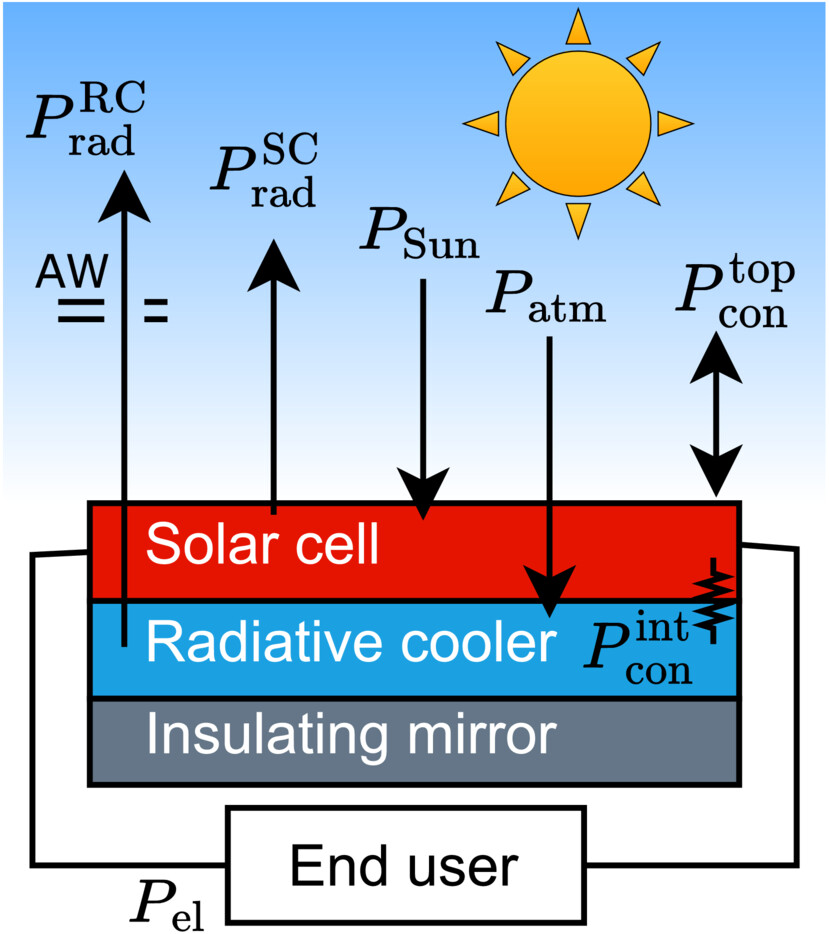Researchers at the Politecnico di Torino in Italy have sought to quantify the potential positive effects of radiative coolers made of cement paste on the performance of photovoltaic cells. These coolers are often used for thermal management in buildings and have strong potential due to the low costs of the material they are made with.
Radiative cooling occurs when the surface of an object absorbs less radiation from the atmosphere and emits more. As a result, the surface loses heat and a cooling effect can be achieved without the need for power.
“The goal of this work was to improve the detailed balance model commonly employed in the literature to assess radiative coolers for solar cells,” the research's corresponding author, Matteo Cagnoni, told pv magazine. “In particular, we were interested in the inclusion of non-radiative recombination channels and the thermal contact resistance at the cell/cooler interface.”
According to Cagnoni, cement-based radiative coolers have poor adhesion properties, which may cause a large thermal contact resistance that might hinder heat flow from the cell to the cooler, hence preventing cooling.
“If this challenge is overcome, we believe that this concept will be very interesting in the context of building-integrated photovoltaics (BIPV) – as a matter of fact, there are reports in the literature of solar cells built onto building structural elements such as shingles,” he explained, noting that the costs of such a module may be only slightly higher than those without the cooler, thanks to the reliance on cheap, scalable and robust cement-based materials.
In the paper “Extended detailed balance modeling toward solar cells with cement-based radiative coolers,” published in Progress in Photovoltaics, the research group demonstrated that the cement-based coolers, which they originally developed in 2022, could approach the spectrum of the ideal broad-band emitter for solar cells.
The scientists incorporated Auger (AUG) and Shockley-Read-Hall (SRH) nonradiative recombination into their modeling.
Auger recombination consists of a non-radiative process that reduces photovoltaic cell efficiency below the ideal radiative limit. It consists of the energy given to a third carrier which is excited to a higher energy level without moving to another energy band. This energy is dissipated not by photon emission, but rather by raising the kinetic energy of another free carrier.
Popular content
SRH nonradiative recombination, which is also known as trap-assisted recombination, describes energy states that are called traps and are created by the electron in transition between bands. This electron passes through a new energy state created within the band gap by a dopant or a defect in the crystal lattice.
“Beside trivially reducing the overall power conversion efficiency, these mechanisms also increase the cell operating temperature and the reduction rate of its efficiency with increasing temperature,” the scientists stated. “Neglecting nonradiative recombination may lead to an underestimation of the benefits provided by a radiative cooler, with these benefits being slightly weakened, but far from negligible, in cells well-described by the radiative limit.”
They also claimed to have demonstrated that a thermal contact resistance at the cell/cooler interface creates the conditions for perfect thermal coupling and isothermal system, complete thermal decoupling, and partial reduction of the cooling effect. “The finite heat transfer coefficient is going to weaken these benefits, but we have defined design guidelines that should enable device engineers to identify the minimum value of this parameter needed to obtain the desired cooling performance,” they concluded.
Radiative cooling was recently applied to solar panel cooling by researchers from the University of Nottingham in the United Kingdom, Shanghai Jiao Tong University in China, Purdue University in the United States, the Catalan Institute of Nanoscience and Nanotechnology and the Instituto de Ciencia de Materiales in Spain, and the Jordan University of Science and Technology and the Australian College of Kuwait.
This content is protected by copyright and may not be reused. If you want to cooperate with us and would like to reuse some of our content, please contact: editors@pv-magazine.com.



1 comment
By submitting this form you agree to pv magazine using your data for the purposes of publishing your comment.
Your personal data will only be disclosed or otherwise transmitted to third parties for the purposes of spam filtering or if this is necessary for technical maintenance of the website. Any other transfer to third parties will not take place unless this is justified on the basis of applicable data protection regulations or if pv magazine is legally obliged to do so.
You may revoke this consent at any time with effect for the future, in which case your personal data will be deleted immediately. Otherwise, your data will be deleted if pv magazine has processed your request or the purpose of data storage is fulfilled.
Further information on data privacy can be found in our Data Protection Policy.